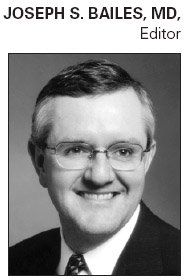EMR Lite: The first step toward electronic records
Electronic medical records have been shown to reduce operating costs, increase efficiency, and improve quality of care. Why then has the adoption rate of e-technology been so sluggish?
ABSTRACT: For the tentative practitioner, EMR-Lite offers a toe in the water that allows the practice to dive in to a full EMR system later on.
Electronic medical records have been shown to reduce operating costs, increase efficiency, and improve quality of care. Why then has the adoption rate of e-technology been so sluggish?
Common worries cited among today’s fiscally challenged community oncologists include upfront expenditures and costly disruption to office workflow. However, according to IT “futurist,” Mark
Anderson, apprehension about transforming a paper office to an interoperable electronic office can be allayed by taking a less invasive first step that he calls “EMR-Lite.”
In an interview, Mr. Anderson, who heads the AC Group, a healthcare technology advisory and research firm, said that 62% of physicians surveyed by the AC Group who did not have an electronic medical record (EMR) system were looking for an application easier to implement and use than a full-service EMR.
“That’s how we came up with EMR-Lite, which is basically all the information traditionally captured by the nurse or medical assistant when a patient first enters the physician’s office,” he said.
Since all the pertinent data prior to the actual E&M visit have already been logged or scanned in, the doctor uses the system essentially as a record and to place orders for treatments or medications.
Speaking to the concern some doctors have about losing their “hands-on” approach, he said,

“With EMR-Lite, doctors can still dictate reports and carry on practicing medicine as usual, except they now have a digital record and order form. And 3 or 4 years down the line, if they decide to embrace a full EMR system, all their charts and records are electronic, making for an easy transition.”
Often, everything involved in an EMR purchase, from servers and scanners to software and services, can be bundled into one predictable monthly payment, making it easy to budget. However, choosing the right EMR can be daunting, especially for practitioners who want to start off with an EMR-Lite system. Mr. Anderson’s group is currently tracking about 380 vendors selling EMR-type systems. “Although 62% of the doctors we surveyed want to start off with an EMR-Lite system, we found that very few vendors want to sell that kind of package; they want to sell the whole EMR system. Their pitch is simple: ‘You’re going to eventually transition to a complete EMR, why wait?’”
Mr. Anderson’s advice is to purchase the system that best suits the needs of the practice, and in many cases, that proves to be an EMR-Lite. “Doctors need to find vendors who are willing to implement a modular approach to setting up a system, ie, to start you on EMR-Lite with a progressive plan to add the rest of the components at a later date,” he said.
Some doctors are concerned about unforeseen technical problems associated with fluid connectivity when and if they decide to transition to a full EMR. Mr. Anderson pointed out, however, that the 2008 government-initiated Certification Commission for Healthcare Information Technology (CCHIT) standard requires interoperability between HIT products.
“So as long as you buy from a vendor that has adopted the CCHIT standards, when the time comes to move to a full EMR, all the data and systems will be transferable,” Mr. Anderson said.
Oncology Peer Review On-The-Go: Cancer Care Management During the COVID-19 Pandemic
October 28th 2020The newest episode of Oncology Peer Review On-The-Go speaks with 2 authors of an article from the October Issue of the journal ONCOLOGY focusing on effective cancer care management during the coronavirus pandemic.